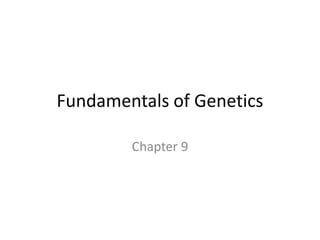
Chapter 9 notes
- 1. Fundamentals of Genetics Chapter 9
- 3. Mendel’s Legacy • Genetics is the study of how characteristics are transmitted from parents to offspring – Founded with the work of Gregor Mendel, an Austrian monk
- 4. Gregor Mendel • Mendel conducted experiments at the monastery with pea plants • He researched heredity – the transmission of characteristics from parents to offspring
- 5. Mendel’s Garden Peas • Mendel observed seven characteristics of pea plants • Each characteristic occurred in two contrasting traits – genetically determined variants of a characteristic
- 6. Mendel’s Garden Peas Characteristic Trait • Position of flowers along stem • Height of plant
- 7. Mendel’s Garden Peas Characteristic Trait • Pod Appearance • Pod color
- 8. Mendel’s Garden Peas Characteristic Trait • Seed Texture • Seed color • Flower color
- 9. Mendel’s Methods • Mendel controlled pollination – Self-pollination – pollen fertilizes egg cells on the same flower – Cross-pollination – pollen fertilizes egg cells on flowers of different plants
- 10. Mendel’s Experiments • P generation – parent generation • F1 (first filial) generation – offspring of the P generation • F2 (second filial) generation – offspring of the F1 generation
- 11. Mendel’s Experiments • First he grew true- breeding plants – A plant that is true- breeding, or pure, for a trait always produces offspring with that trait when they self-pollinate
- 12. Mendel’s Experiments • Next, he cross- pollinated true- breeding parents of the P generation • What do you think the F1 generation looked like?
- 13. Mendel’s Experiments • The F1 generation was all purple flowers!
- 14. Mendel’s Experiments • Next, he let the flowers from the F1 generation self-pollinate • What do you think the F2 generation looked like?
- 15. Mendel’s Experiments • The F2 generation came out with 75% purple flowers and 25% white flowers!
- 16. Mendel’s Results and Conclusions • Mendel’s observations led him to hypothesize that something within the pea plants controlled the characteristics observed – He called these controls factors • Because the characteristics had two alternative forms, he reasoned that a pair of factors must control each trait
- 17. Recessive and Dominant Traits • Dominant – trait that masks the factor for the other trait • Recessive – trait that is masked by the factor for the other trait
- 18. The Law of Segregation • The law of segregation states that a pair of factors is segregated, or separated, during the formation of gametes
- 19. The Law of Independent Assortment • The law of independent assortment states that factors separate independently of one another during the formation of gametes
- 20. Support for Mendel’s Conclusions • A gene is a segment of a chromosome that controls a particular hereditary trait • The different forms of a gene are called alleles – Capital letters are used to represent dominant alleles – Lowercased letters are used to represent recessive alleles
- 22. Genotype and Phenotype • Genotype – an organism’s genetic makeup (PP, Pp, pp) • Phenotype – an organism’s physical appearance (purple flower, white flower)
- 23. Genotype and Phenotype • Homozygous – both alleles of a pair are alike (PP = homozygous dominant and pp = homozygous recessive) • Heterozygous – two alleles are different (Pp)
- 24. Probability • Probability – the likelihood that a specific event will occur
- 25. Predicting Results of Monohybrid Crosses • In a monohybrid cross, one characteristic is tracked • Biologists use a Punnett square to predict the probable distribution of inherited traits in the offspring
- 26. Ex 1: Homozygous X Homozygous • TT x tt (T = tall, t = short) • Possible Genotypes – 100% Tt • Possible Phenotypes – 100% tall
- 27. Ex 2: Homozygous X Heterozygous • BB X Bb (B = black hair, b = brown hair) • Possible Genotypes – 50% BB, 50% Bb • Possible Phenotypes – 100% black
- 28. Ex 3: Heterozygous X Heterozygous • Bb X Bb(B = black hair, b = brown hair) • Possible genotypes – 25% BB, 50%Bb, 25% bb • Possible phenotypes – 75% black hair, 25% brown hair
- 29. Ex 4: Testcross • How could you determine whether a black guinea pig is homozygous (BB) or heterozygous (Bb)? • By completing a testcross – an individual with an unknown genotype is crossed with a homozygous recessive individual
- 30. Ex 5: Incomplete Dominance • Incomplete dominance occurs when the phenotype of heterozygous individual is in between the two homozygous phenotypes
- 31. Ex 5: Incomplete Dominance • RW X RW (R = red, W = white) • Possible genotypes and phenotypes – 25% RR, red – 50% RW, pink – 25% WW, white
- 32. Ex 6: Codominance • In codominance, both alleles contribute to the phenotype • In some varieties of chicken, the allele for black feathers is codominant with the allele for white feathers – Heterozygous chickens are speckled with black and white feathers
- 33. Ex 6: Codominance • F W FW X F B F B (F = feathers, B = black, W = white • Possible genotypes and phenotypes – 100% FWFB, speckled
- 34. Predicting Results of Dihybrid Crosses • A dihybrid cross is a cross in which two characteristics are tracked • More complicated than monohybrid crosses because more combinations of alleles are possible
- 35. Dihybrid Homozygous X Homozygous • rryy X RRYY (R= round, r= wrinkled, Y= yellow, y= green)
- 36. Dihybrid Heterozygous X Heterozygous • RrYy X RrYy